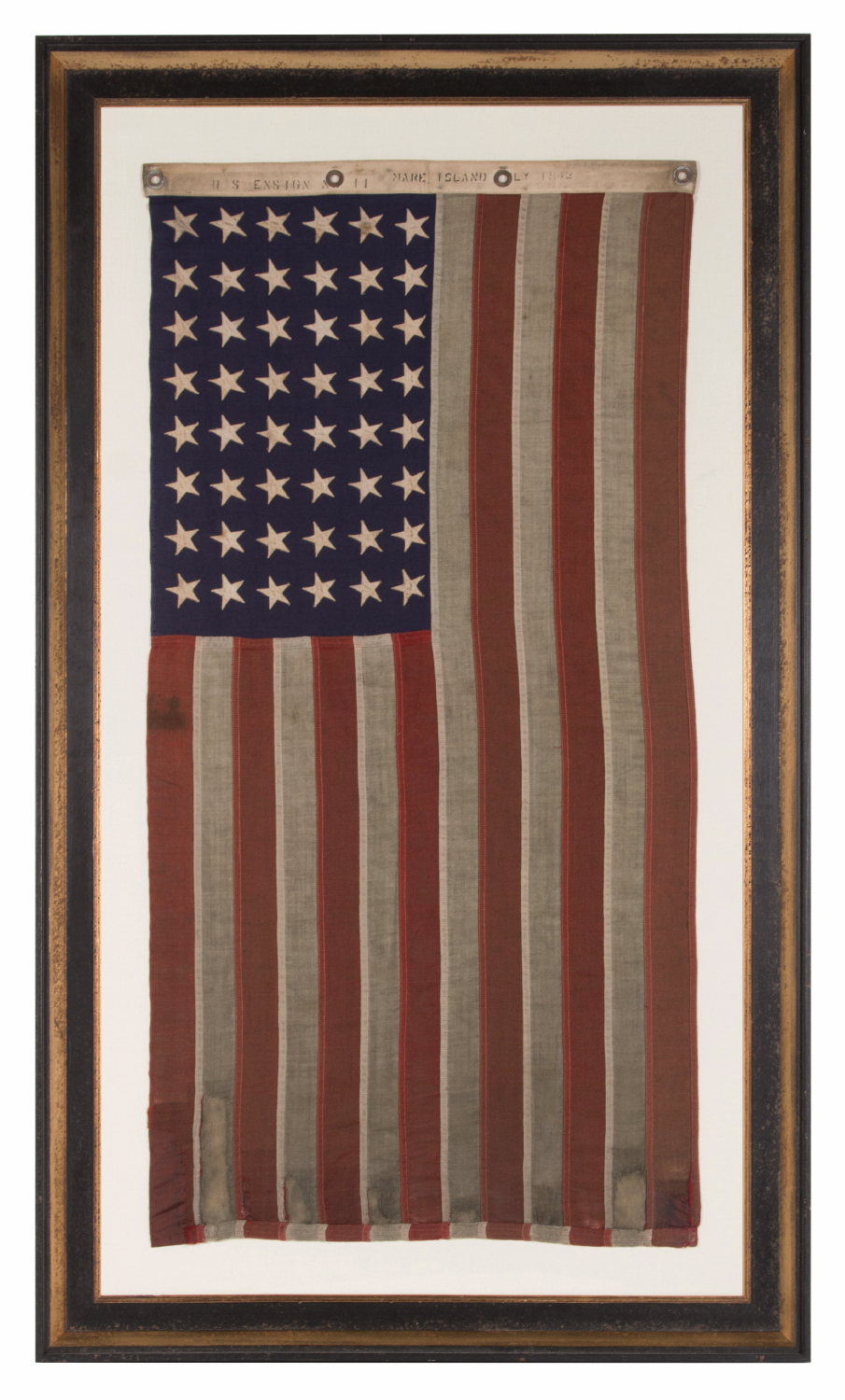
| |
48 STAR, U.S. NAVY SMALL BOAT ENSIGN, MADE AT MARE ISLAND, CALIFORNIA [HEADQUARTERS OF THE PACIFIC FLEET] DURING WWII, SIGNED AND DATED JULY 1942, WITH EXTENSIVE WEAR FROM OBVIOUS USE |
|
| Available: |
Sold |
| Frame Size (H x L): |
65.75" x 38.25" |
| Flag Size (H x L): |
54.25" x 27.25" |
|
| Description....: |
|
48 star American national flag, made during World War II (U.S. involvement 1941-45) and signed along the reverse side of the hoist with a black stencils that read: "U.S. Ensign No. 11" MI 44” and "Mare Island July 1942." Located on the western edge of the City of Vallejo, about 23 miles northeast of San Francisco, Mare Island (actually a peninsula) served as a principal seat of U.S. Navy defense, beginning in the mid-19th century. The site was originally chosen following an expedition that set forth in 1850, when Commodore John Drake Sloat was ordered to lead a survey party in quest of a logical site for the nation's first Pacific naval installation. Sloat recommended the island across the Napa River from the settlement of Vallejo; it being "free from ocean gales and from floods and freshets." On November 6th of that year, two months after California was admitted to statehood, President Fillmore reserved Mare Island for government use. The U.S. Navy Department acted favorably on Commodore Sloat's recommendations and Mare Island was purchased in July, 1852, for the sum of $83,410 for use as a naval shipyard. Two years later, on September 16th of 1854, Mare Island became the first permanent U.S. naval installation on the West Coast, with Commodore David G. Farragut serving as Mare Island's first base commander.
The base became home to what was known as the Pacific Fleet, and remained so until the threat of Japanese expansionism caused the shift to a more advanced position at Pearl Harbor. It was very active in WWII, Korea, and Vietnam, but would eventually close in 1993 after Congress approved the findings of the Base Realignment and Closure Report.
The canton and stripes of the flag are made of wool bunting that has been pieced and sewn with machine stitching. The stars are made of cotton and are double-appliquéd with a zigzag machine stitch. There is a heavy canvas binding along the hoist with 4 brass grommets. The weight of the wool and the stalwart construction is typical of what the Navy preferred for its flags in this period. The fabric is heavier grade than what was usually employed in commercially-made flags and the fly end is bound with 4 rows of stitching instead of the usual two encountered in standard, commercially-made flags. “No. 11” is a size designation for U.S. Navy small boat ensigns, specifying a flag that was to be 2.37 x 4.5 feet. Measuring approx. 27.25" on the hoist and 54.25" on the fly, this was the second to the smallest variety of Stars & Stripes in use by the Navy in 1942. This small scale is especially nice for collectors, because it is so easily framed and displayed.
The flag was found among the holdings of an elderly collector from Kansas. Although it has no specific history of use, it was sewn during wartime, undoubtedly saw wartime use, and was flown for extended period. The endearing wear makes for a presentation that shows both its age and function.
The 48 star flag became official in 1912 following the addition of New Mexico and Arizona. 48 remained the official star count throughout WWI (U.S. involvement 1917-18), WWII, and the Korean War (1950-53), until Alaska gained statehood in 1959 and the 49th star was added.
Mounting: The flag was mounted and framed within our own conservation department, which is led by masters degree trained staff. We take great care in the mounting and presentation of flags and have preserved thousands of examples; more than anyone worldwide.
The background is hemp fabric, ivory in color. The mount was placed in a black-painted, hand-gilded and distressed Italian molding. The glazing is U.V. protective plexiglass. Feel free to contact us for more details.
Condition: There is moderate loss along the fly end, primarily in the 1st, 2nd, and last red stripes, and the white stripes, from obvious use. Fabric of similar coloration was placed behind these areas during the mounting process. There is significant soiling throughout, particularly at the fly end and in the top center of the top stripe, and there is minor fading. There is corrosion on the metal grommets. Many of my clients prefer early flags to show their age and history of use. |
|
|
|
| Collector Level: |
Intermediate-Level Collectors and Special Gifts |
|
| Flag Type: |
Sewn flag |
|
| Star Count: |
48 |
|
| Earliest Date of Origin: |
1942 |
|
| Latest Date of Origin: |
1942 |
|
| State/Affiliation: |
California |
|
| War Association: |
WW 2 |
|
| Price: |
SOLD |
|
| |
Views: 1817 |
|
|
|

